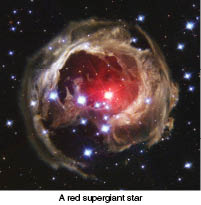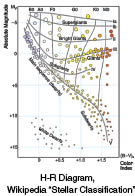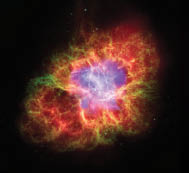In modern times we have seen many other lessons that can be drawn from
the creation, and these have been used in ecological situations,
political situations, and lessons about the Church. Stars are often
used as devices to instruct us how to live. In Philippians 2:14-16 we
are told “Do everything without complaining or arguing, so that you may
become blameless and pure, children of God without fault in a crooked
and depraved generation, in which you shine like stars in the universe
as you hold out the word of life” (NIV). That passage is appropriate
for those of us living in the twenty-first century, not only because of
the condition of the world in which we live, but because of how much
more we know about stars than we did at the time Philippians was
written. Let us look at some of the lessons that come from stars.
A casual observer looking up at the night sky will notice that stars
are not all the same. Even with our naked eye we can tell that some
stars are brighter than others and stars have different colors. As our
telescopes have improved we have seen that these variations are not
caused just by the distance to the star, but also by the methods the
stars use to produce their light. These methods vary from star to star.
THERE
ARE MANY KINDS OF STARS
Some stars are blue and incredibly hot. They give off dangerous
radiation, destroying anything close to them, and their life expectancy
is relatively short. Some stars are red or brown and relatively cold.
These stars are inactive and are really like corpses. Some stars
pulsate at frequencies ranging from a fraction of a second to years.
There can be a variety of causes of these pulsations ranging from rapid
spinning to actual inflation and deflation of their size. There are
even stars that have such huge masses that they literally suck in
everything that is in their reach, and they not only do not give off
light but they actually prevent light from leaving. They are selfish
takers, taking everything and giving nothing--black ugly swallowers
called black holes. Stars can explode; they can flare giving off
massive blasts of radiation and/or particles. They can even give off
radiation, that is not visible to us, bathing space with gamma rays,
X-rays, ultraviolet, microwaves, or radio waves.

Stars like our sun are not the most common type of stars
in space. It is not common for a star to give off the right wavelengths
to enable photosynthesis--to be free of massive flares or pulses, to be
at a temperature that allows a large zone of liquid water and carbon
compounds to exist, and to have a very long life expectancy allowing
stability for vast periods of time.
As you read through this brief and superficial description of stars,
one thing I hope will occur to you is that people are very much like
these stars. Unlike the stars, however, our choice of how to live our
lives is voluntary. Some of us are like giant blue stars. We live our
life recklessly burning everyone who touches us. Our energy is not
constructive, and our life expectancy is short. Some of us are like red
and brown dwarf stars; we float through life not doing much and making
no impact on those whose lives we can touch. Some of us are like flare
stars, erupting in destructive behavior that hurts others and
diminishes our effectiveness and usefulness. Some of us are like black
holes, taking and selfishly absorbing everything we can get our hands
on.
We all have the capacity to be like our sun. We were created to radiate
good things to the world around us, to promote life, and to give
stability to those we touch. The teachings of Christ emphasize this as
He portrays His followers as workers that bless others. “I was hungry
and you gave me something to eat, I was thirsty and you gave me
something to drink, I was a stranger and you invited me in, I needed
clothes and you clothed me, I was sick and you looked after me, I was
in prison and you came to visit” (Matthew 25:35-36, NIV). He goes on to
say that what He was talking about was what they did for those they had
contact with in life. Only the followers of Jesus Christ have this
binding responsibility to be stars that bring blessings to others.
Those who believe in “survival of the fittest” as the basis of their
moral code will not bless those who ultimately will drain their own
personal resources. In John 13 Jesus drove this point home strongly as
He washed the disciples’ feet and told them “I have set you an example
that you should do as I have done for you.”

THE
KIND OF STAR DICTATES WHAT IS ATTRACTED TO IT AND SURROUNDS IT
As we watch these different stars and how they behave, we come to
understand how much the type of star affects what can be around it. Hot
blue stars have massive amounts of debris around them which reflects
light to us. Rapidly pulsating stars and giant stars have limited
capacity for any objects to be close to their surface. Black holes have
an event horizon which limits how close anything can get to them. Dwarf
stars cannot have sizable objects at a great distance from their
surface. Astronomers know what to look for in different star types and
observations continue to confirm the accuracy of these understandings.
We can compare this to humans. The Bible uses the word “heart” in a way
that describes a person and how the person affects others. Romans
1:18-21 describes people who become alienated from God as people whose
“foolish hearts were darkened.” On the other hand, Jesus said, “Blessed
are the pure in heart: for they shall see God” (Matthew 5:8). Our
children sing the song “This little light of mine, I’m going to let it
shine” and it is our heart that shines out the love of God. As Jesus
said, “A good man out of the good treasure of the heart bringeth forth
good things: and an evil man out of the evil treasure bringeth forth
evil things” (Matthew 12:35). The kinds of friends and associates who
are attracted to us are a function of the kind of person we are, and
how we have allowed ourselves to be molded into what God would have us
to be.
STARS
AGE AND ULTIMATELY DIE

One fundamental law of physics is that everything in the
creation ages and approaches death (disorder). This applies to
everything from fundamental particles to galaxies. The diagram to the
right is called the “Hertzsprung-Russell Diagram.” What it shows is how
stars age. Stars begin in the upper left hand corner as very hot very
bright stars. As time goes by they age cooling and changing in color
from blue to white to yellow to orange to red. Some stars do this very
quickly, and some take massively long periods of time to do it. We
cannot watch a single star go through the process because our own life
span is so short compared to that of a star. In Daniel 12:3 we are told
that “those who are wise will shine like the brightness of the heavens,
and those who lead many to righteousness, like the stars for ever and
ever” (NIV). Mankind can see stars doing the things the
Hertzsprung-Russell diagram tells us about, but our existence is so
brief compared to stars that we never see one star do the whole process.

Even with stars having such long life expectancies, they
ultimately die. The less active stars simply cool and become cinders,
stellar corpses floating in space. Some stars however, change the way
in which they produce their energy and are renewed. These stars explode
in spectacular ways spewing new elements into space. These new elements
are the building blocks of new stars and of planets. This appears to be
the method God has used to form the physical world in which we live-the
dust of the earth, and we ourselves are made of star dust. We are also
told in 2 Peter 3:10 that this dust and the very elements of which the
creation is made will ultimately be dissolved. Death is inevitable for
all that is not spiritual in nature.
STARS
LEAVE A LEGACY
As we learn about stars and how they function, we see that all stars
have an ultimate legacy that they will leave behind. It appears that
black holes will continue to absorb everything that comes within reach
and will never be anything other than a black hole. Cinders will
continue to float through space as stellar corpses. For many stars the
future has little to offer or to be excited about.
There are stars, however, that have an exciting future. They are
designed in such a way that ultimately they will become something
called a nova or supernova. In 1987 scientists saw a star go through
this process, the first nearby supernova since 1054 when the Chinese
saw one which today is called the Crab Nebula. These stars give their
region of space new elements that can make terrestrial planets. They
can also supply new kinds of stars that are more stable and have the
capacity to support planets like our earth. Whether this is the method
God has used in the past, whether He has done it more than once, and
whether He will do it in the future is all speculative, but the fact is
that we see this happening and it has some wonderful messages for us.
We too have a legacy--something that is positive about our existence
and the future. We can build and encourage and support others and
glorify God and Jesus Christ as we do so, or we can selfishly consume
everything we find and do nothing for those we meet. Unlike the stars,
we have a choice. Also unlike the stars we have a promise of an
existence that is free of death and the struggles of this life. What is
your legacy going to be? Are you a black hole of selfishness or a giver
of service and blessings? Take a lesson from the stars.


 There are many
lessons that can be drawn from what we see in the world around us. Not
only can we gain confidence in the existence of God by seeing His
wisdom and intelligence in the creation around us (Romans 1:19-20), but
we can draw many lessons from the objects and living things in the
creation. We are told in Scripture to learn from ants (Proverbs 6:6),
and countless lessons are presented in the Bible from sheep, goats,
eagles, lions, dogs, bears, and birds.
There are many
lessons that can be drawn from what we see in the world around us. Not
only can we gain confidence in the existence of God by seeing His
wisdom and intelligence in the creation around us (Romans 1:19-20), but
we can draw many lessons from the objects and living things in the
creation. We are told in Scripture to learn from ants (Proverbs 6:6),
and countless lessons are presented in the Bible from sheep, goats,
eagles, lions, dogs, bears, and birds. Stars like our sun are not the most common type of stars
in space. It is not common for a star to give off the right wavelengths
to enable photosynthesis--to be free of massive flares or pulses, to be
at a temperature that allows a large zone of liquid water and carbon
compounds to exist, and to have a very long life expectancy allowing
stability for vast periods of time.
Stars like our sun are not the most common type of stars
in space. It is not common for a star to give off the right wavelengths
to enable photosynthesis--to be free of massive flares or pulses, to be
at a temperature that allows a large zone of liquid water and carbon
compounds to exist, and to have a very long life expectancy allowing
stability for vast periods of time.
 One fundamental law of physics is that everything in the
creation ages and approaches death (disorder). This applies to
everything from fundamental particles to galaxies. The diagram to the
right is called the “Hertzsprung-Russell Diagram.” What it shows is how
stars age. Stars begin in the upper left hand corner as very hot very
bright stars. As time goes by they age cooling and changing in color
from blue to white to yellow to orange to red. Some stars do this very
quickly, and some take massively long periods of time to do it. We
cannot watch a single star go through the process because our own life
span is so short compared to that of a star. In Daniel 12:3 we are told
that “those who are wise will shine like the brightness of the heavens,
and those who lead many to righteousness, like the stars for ever and
ever” (NIV). Mankind can see stars doing the things the
Hertzsprung-Russell diagram tells us about, but our existence is so
brief compared to stars that we never see one star do the whole process.
One fundamental law of physics is that everything in the
creation ages and approaches death (disorder). This applies to
everything from fundamental particles to galaxies. The diagram to the
right is called the “Hertzsprung-Russell Diagram.” What it shows is how
stars age. Stars begin in the upper left hand corner as very hot very
bright stars. As time goes by they age cooling and changing in color
from blue to white to yellow to orange to red. Some stars do this very
quickly, and some take massively long periods of time to do it. We
cannot watch a single star go through the process because our own life
span is so short compared to that of a star. In Daniel 12:3 we are told
that “those who are wise will shine like the brightness of the heavens,
and those who lead many to righteousness, like the stars for ever and
ever” (NIV). Mankind can see stars doing the things the
Hertzsprung-Russell diagram tells us about, but our existence is so
brief compared to stars that we never see one star do the whole process. Even with stars having such long life expectancies, they
ultimately die. The less active stars simply cool and become cinders,
stellar corpses floating in space. Some stars however, change the way
in which they produce their energy and are renewed. These stars explode
in spectacular ways spewing new elements into space. These new elements
are the building blocks of new stars and of planets. This appears to be
the method God has used to form the physical world in which we live-the
dust of the earth, and we ourselves are made of star dust. We are also
told in 2 Peter 3:10 that this dust and the very elements of which the
creation is made will ultimately be dissolved. Death is inevitable for
all that is not spiritual in nature.
Even with stars having such long life expectancies, they
ultimately die. The less active stars simply cool and become cinders,
stellar corpses floating in space. Some stars however, change the way
in which they produce their energy and are renewed. These stars explode
in spectacular ways spewing new elements into space. These new elements
are the building blocks of new stars and of planets. This appears to be
the method God has used to form the physical world in which we live-the
dust of the earth, and we ourselves are made of star dust. We are also
told in 2 Peter 3:10 that this dust and the very elements of which the
creation is made will ultimately be dissolved. Death is inevitable for
all that is not spiritual in nature.